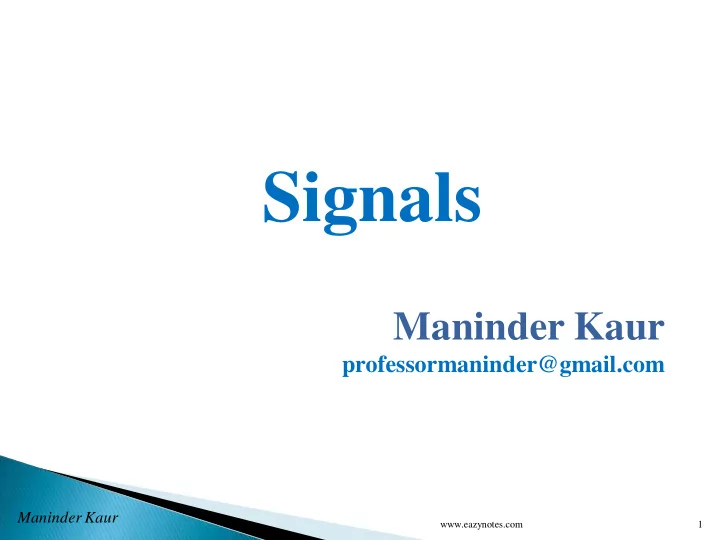

Signals Maninder Kaur professormaninder@gmail.com Maninder Kaur www.eazynotes.com 1
Various types of Signals • Analog and digital • Aperiodic and periodic signals • Analog signals • Digital Signals . Maninder Kaur www.eazynotes.com 2
Analog signals are continuous electrical signals. Analog signals is a continuous wave from that changes smoothly over time. Analog signal is usually represented by sine wave. For e.g. Analog data is the human voice. When somebody speaks, a continuous wave is created in the air. This can be captured by a microphone and converted to an analog signal. Maninder Kaur www.eazynotes.com 3
Best suited for the transmission of audio and video. Consume less bandwidth than digital signals to carry the same information. Analog signal is less susceptible to noise. Maninder Kaur www.eazynotes.com 4
Digital signals are non-continuous, they change in individual steps. They consist of pulses or digits with discrete levels or values. In digital signals 1 is represented by having a positive voltage and 0 is represented by having no voltage or zero voltage. All the signals generated by computers and other digital devices are digital in nature. Maninder Kaur www.eazynotes.com 5
For exa xample ple: Data stored in the memory of a computer in the form of 0s and 1s. It is usually converted to a digital signal when it is transferred from one position to another inside or outside the computer. Bit it rat rate : The bit rate represents the number of bits sent per second. Baud aud rat ate: the baud rate defines the number of signal elements per second in the signal. Depending on the encoding technique used, baud rate may be more than or less than the data rate. Maninder Kaur www.eazynotes.com 6
Best suited for the transmission of digital data. Digital data can be easily compressed. Digital information can be encrypted. Provides better clarity because all signals must be either 1s or 0s. www.eazynotes.com 7
Transformation of Information to Signals Maninder Kaur www.eazynotes.com 8
Analog and Digital Clocks Maninder Kaur www.eazynotes.com 9
Analog and Digital Signals Maninder Kaur www.eazynotes.com 10
Signal which completes a pattern within a measurable time frame called a Period, and repeats that pattern over identical subsequent periods. Period: Amount of time (in sec) required to complete one full Cycle. Duration of a period represented by T, may be different for each signal, but constant for any given periodic signal. Cycle: The completion of one full pattern is called a Cycle. Maninder Kaur www.eazynotes.com 11
Periodic Signals Maninder Kaur www.eazynotes.com 12
Signal changes constantly without exhibiting a pattern or cycle that repeats over time. Maninder Kaur
Sine Wave An periodic signal can be decomposed into an infinite number of periodic signals. A Sine Wave is the simplest periodic signal. Maninder Kaur www.eazynotes.com 14
Frequency is the rate of change with respect to time. Change in a short span of time means high frequency. Change over a long span of time means low frequency. ◦ If a signal does s not change e at all, its frequen ency cy is zero. ◦ If a signal changes ges insta tanta taneo eousl sly, y, its frequen ency cy is infinite. te. Maninder Kaur www.eazynotes.com 15
The term phase describes the position of the waveform relative to time zero. Phase describes the position of the waveform relative to time zero. Phase is measured in degree of radians. Maninder Kaur www.eazynotes.com 16
Maninder Kaur www.eazynotes.com 17
Wavelength is another characteristic of a signal travelling through a transmission medium. Wavelength binds the period or the frequency of a simple sine wave to the propagation speed of the medium. While the frequency of a signal is independent of the medium, the wavelength depends on both the frequency and the medium. Maninder Kaur www.eazynotes.com 18
Maninder Kaur www.eazynotes.com 19
Maninder Kaur www.eazynotes.com 20
Recommend
More recommend